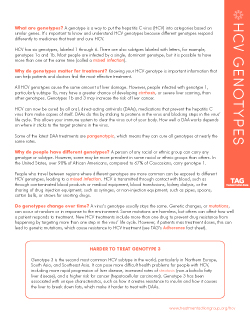February 2017
What are genotypes?
A genotype is a way to put the hepatitis C virus (HCV) into categories based on similar genes. It’s important to know and understand HCV genotypes because different genotypes respond differently to medicines that treat and cure HCV.
HCV has six genotypes, labeled 1 through 6. There are also subtypes labeled with letters, for example, genotypes 1a and 1b. Most people are infected by a single, dominant genotype, but it is possible to have more than one at the same time (called a mixed infection).
Why do genotypes matter for treatment?
Knowing your HCV genotype is important information that can help patients and doctors find the most effective treatment.
All HCV genotypes cause the same amount of liver damage. However, people infected with genotype 1, particularly subtype 1b, may have a greater chance of developing cirrhosis, or severe liver scarring, than other genotypes. Genotypes 1b and 3 may increase the risk of liver cancer.
HCV can now be cured by all oral, direct-acting antivirals (DAAs), medications that prevent the hepatitis C virus from make copies of itself. DAAs do this by sticking to proteins in the virus and blocking steps in the virus’ life cycle. This allows your immune system to clear the virus out of your body. How well a DAA works depends on where it sticks to the target proteins in the virus.
Some of the latest DAA treatments are pangenotypic, which means they can cure all genotypes at nearly the same rates.
Why do people have different genotypes?
A person of any racial or ethnic group can carry any genotype or subtype. However, some may be more prevalent in some racial or ethnic groups than others. In the United States, over 90% of African Americans, compared to 67% of Caucasians, carry genotype 1.
People who travel between regions where different genotypes are more common can be exposed to different HCV genotypes, leading to a mixed infection. HCV is transmitted through contact with blood, such as through contaminated blood products or medical equipment, blood transfusions, kidney dialysis, or the sharing of drug injection equipment, such as syringes, or non-injection equipment, such as pipes, spoons, cotton balls, or straws for snorting drugs.
Do genotypes change over time?
A virus’s genotype usually stays the same. Genetic changes, or mutations, can occur at random or in response to the environment. Some mutations are harmless, but others can affect how well a patient responds to treatment. New HCV treatments include more than one drug to prevent drug resistance from happening by targeting more than one step in the virus’ life cycle. However, if patients miss treatment doses, this can lead to genetic mutations, which cause resistance to HCV treatment (see TAG’s Adherence fact sheet).
HARDER TO TREAT GENOTYPE 3
Genotype 3 is the second most common HCV subtype in the world, particularly in Northern Europe, South Asia, and Southeast Asia. It can pose more difficult health problems for people with HCV, including more rapid progression of liver disease, increased rates of steatosis (non-alcoholic fatty liver disease), and a higher risk for cancer (hepatocellular carcinoma). Genotype 3 has been associated with unique characteristics, such as how it creates resistance to insulin and how it causes the liver to break down fats, which make it harder to treat with DAAs.
People infected with genotype 3 are the most challenging to treat if they:
- have previously tried treatment (are treatment-experienced)
- have cirrhosis, and
- have decompensated liver disease, which is a life-threatening condition leading to liver failure.
Genotype 3 often requires longer treatment and does not achieve strong cure rates. There are lower cure rates in patients with cirrhosis.
What tests are needed for knowing my genotype?
When screening for HCV, a patient takes several tests to make a diagnosis (see HCV Diagnostics fact sheet).
Once a patient has been diagnosed with HCV, the doctor will run viral load level and genotype tests before starting treatment. Knowing a patient’s genotype determines the best treatment regimen.
Genotype tests use blood taken from fingersticks or simple blood draws. A patient might need to return to the doctor’s office to confirm whether the infection is chronic or to confirm whether they have been cured of the virus.
Genotypes 1a and 1b may require a patient to take additional blood tests to determine whether the virus has any resistance (see Adherence fact sheet).
HCV treatment is now simpler, safer, and more effective, and diagnostics, including HCV genotyping, need to become simpler and less expensive.
The medications are available depending on the payer or what is available in a country or region.
Which treatment works for each genotype?
- All Genotypes: see Epclusa fact sheet
- Genotypes 1 through 4: see Sovaldi, Viekira XR and Technivie, Harvoni, Olysio fact sheets
- Genotypes 1 or 4: see Zepatier fact sheet
- Genotypes 2 or 3: see Sovaldi, Daklinza fact sheets
- Genotype 6: see Harvoni fact sheets
Ribavirin (RBV) causes birth defects and miscarriage. HCV treatment regimens that include RBV should not be used by pregnant women or by male partners of pregnant women. RBV stays in a person’s body for months, so women and their male partners should avoid pregnancy until six months after stopping it (see Ribavirin fact sheet).
This fact sheet is current as of December 2016. It is recommended to be read alongside the Adherence and HCV Diagnostics fact sheets. Always check for updated information.

